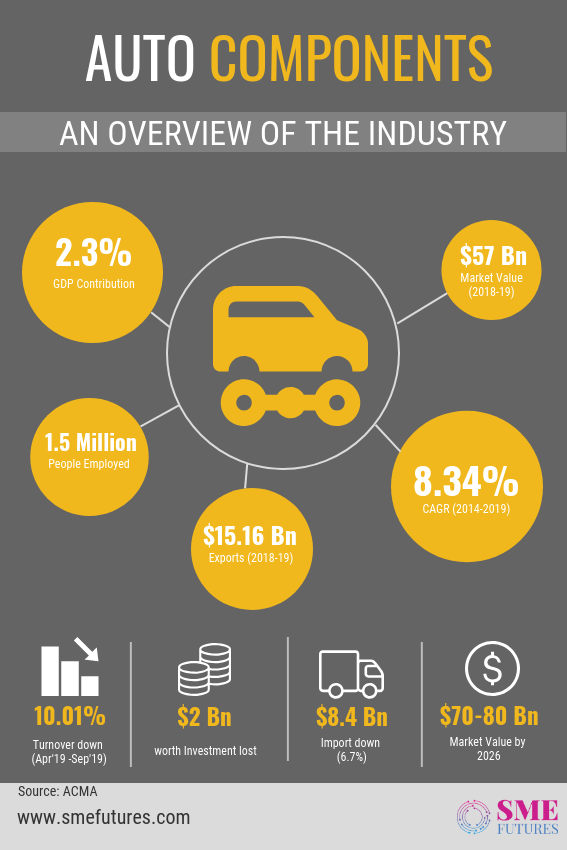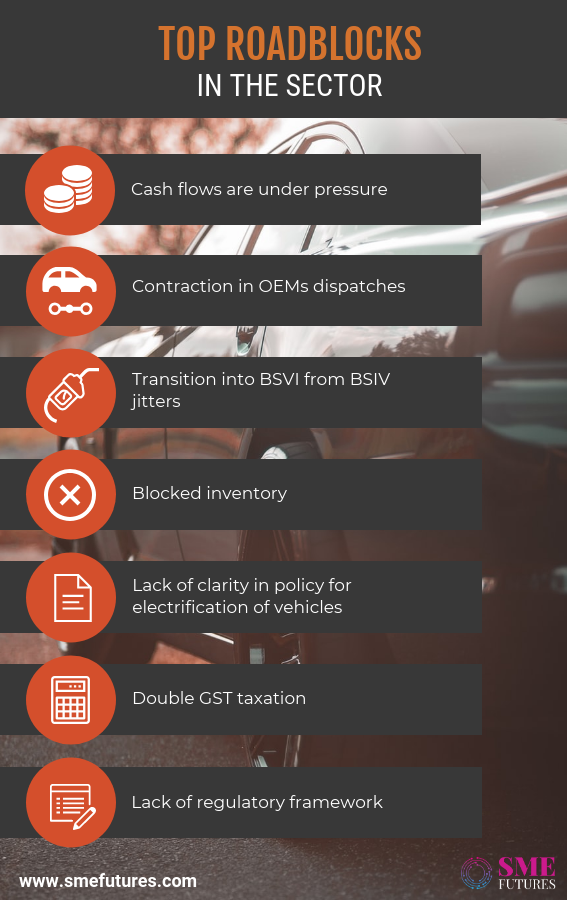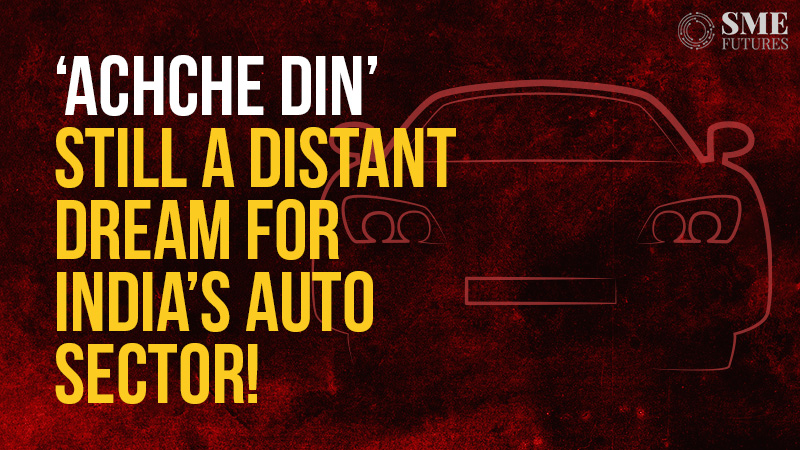There seems to be no end to the challenges faced by the country’s auto component industry.
The industry – which was in the news last year for all the wrong reasons, including ‘steep’ decline in auto sales and massive job layoffs – is staring at new set of challenges. Undergoing a continuous cyclical slowdown for over last few quarters, the sector got a breather during the festive season when the sale picked up; but looks like that was a temporary phase.
The switch from BSIV to BSVI emission standards; electric vehicle promotion and GST cut expectation are causing complete chaos among buyers, resulting into decrease in footfalls in auto showrooms.
In December 2019, vehicle registrations fell by 15 per cent as compared to last year. Two-wheelers were down by 16 per cent, while passenger vehicles saw a 9% per cent decrease and commercial vehicle registered a de-growth of 21 per cent. Only the three-wheeler segment was up by a mere per cent.
Vehicle Registration Data for December’19:
Passenger car sales declined to 1.81 million from 2.24 million in 2018. As per the Society of Indian Automobile Manufacturers (SIAM), car sales fell by record 19 per cent last year.
On the other hand, sales in January 2020 came in at 17,50,116 vehicles comparing to 18,85,253 units sold in January 2019 revealed Federation of Automobiles Dealers Association.
This shows decline in automotive sales in January across all categories by 7.17 per cent, on a year-on-year basis. 2-Wheeler was down by 8.82 per cent, Passenger Vehicles fell by 4.62 per cent and commercial vehicle segment registered a de-growth of 6.89 per cent. Only 3W and Tractors were up by 9.17 per cent and 5.11 per cent respectively.
Vehicle Registration Data for January’20 with YoY comparison
| Category | Dec’19 | Dec’18 | YoY % |
| 2-Wheelers | 12,67,366 | 13,89,951 | -8.82% |
| 3-Wheelers | 63,514 | 58,178 | 9.17% |
| Commercial Vehicles | 82,187 | 88,271 | -6.89% |
| Passenger Vehicles | 2,90,879 | 3,04,929 | -4.61% |
| Tractor | 46,170 | 43, 924 | 5.11% |
| Total | 17,50,116 | 18,85,253 | -7.17% |
Source: FADA Research
“December sales de-growth was not on expected lines as the inquiry levels all through the month was quite robust”
Ashish Harsharaj Kale, president, Federation of Automobiles Dealers Association (FADA)
According to him, though there were enough efforts on providing best offers and sales promotion, which didn’t convert into sales, “Consumer sentiment continues to be very weak as customers did not conclude on the purchase, even after taking efforts of inquiring and despite the best offers being available,” Kale adds.
Bumpy ride for component makers
The decline in sales not just troubled auto dealers, but ancillaries as well. The component industry, that was booming in the first half of 2018-19, eventually went down; and posted subdued performance with exports at US$ 15.16 billion and logged a turnover of US$ 57 billion, according to the Automotive Component Manufacturers
Association of India (ACMA). Contributing 2.3 per cent to the nation’s GDP and providing direct employment to 1.5 million people, the industry expects to clock a turnover of up to US$ 200 billion with the exports reaching US$ 70-80 billion by 2026. During FY14-FY19, India’s auto components exports increased at a CAGR of 8. 34 per cent.
The overall auto component industry turnover plummeted to Rs 1.79 lakh crore in the April-September period last year – down 10.1 per cent from Rs 1.99 lakh crore in the year-ago period. The poor performance, largely on the back of steep decline in vehicle sales, eventually led to massive layoffs of around one lakh temporary workers; and US$ 2 billion investment loss was recorded too. In addition, the import also went down by 6.7 per cent to Rs 57, 574 crore approximately, US$ 8.4 billion.
The situation doesn’t seem to ease out any time sooner. ACMA expects that the first half of FY20 will remain challenging, however things may become relatively better in the second half.
“We had a de-growth in the previous fiscal as the turnover was down by 10 per cent in the period of April-September. It is certainly a cyclical downturn, and difficult to catch up but we are very optimistic for the future. We will have an uptake and we are ready for this”
Deepak Jain, president, ACMA when asked about the current sentiments in the auto industry.
Despite this, rating agency ICRA has forecasted the outlook ‘negative’ due to the continued and broad-based contraction in OEM sales. “Aftermarket demand for components accounts for 18 per cent of the industry turnover, which lately has slowed down with the decline in goods movement and the consequent weakness in freight activity,” the agency said.
The report states that automotive production is expected to hit a multi-year low in FY20 before reviving in the second half of FY21. On the other hand, exports – which account for 26-27 per cent of the total industry revenues – is expected to be muted in the coming quarters. The reason is the global automotive outlook, which has turned negative with a decline in sales across geographies – partly due to heightened trade tensions and other geo-political factors.
Auto component supplier Mahle’s head-sales and application engineering-mechatronics, Jupiter Kalra believes that the poor economic sentiments have impacted auto component makers badly. “In my opinion, the companies which are into a mix of all operations such as exports and aftermarket manufacturing have better chances to survive the slump.”
“OEM market is already down, and it has affected the auto component market and the suppliers’ operations, including us,” Yatendra Pathak, assistant manager, business development at NIFCO India informs SMEFutures.

What’s troubling the auto industry?
The roadblocks in the sector have clearly affected the whole value chain.
- Cash flows are under pressure as demand is subdued
- OEMs dispatches have contracted sharply over the past few months in order to rationalise the system inventory of BSIV components.
- Investments made for the transition to BSVI from BSIV and lack of clarity on policy for electrification of vehicles had an adverse impact on the expansion plans for the component sector.
The component makers are continuously demanding the government to provide relief on policy, regulatory and trade levels.
#Coronavirus outbreak
The recent outbreak of the deadly coronavirus across China and South Asia is impacting several businesses, including the domestic automotive industry.
As per ICRA, there will be differential impact on the industry as certain critical components are sourced from China. These include component for electric vehicles, EGR modules, fuel injection pumps, turbo charger, meter sets, LEDs, magnets, airbag components, steering system components.
China accounts for 27 per cent of India’s auto component imports valued at US$ 4.8 billion.
“India’s automotive supply chain could get disrupted if the manufacturing activities in China continue to remain impacted owing to Coronavirus outbreak,” says Shamsher Dewan, vice president-corporate sector ratings, ICRA Limited. “The impact is estimated to be higher for high value-add and customized components, while commoditized products could shift to alternative suppliers. But high investments and gestation period involved in developing tooling remains the key prohibitive factor for an immediate shift to new suppliers.”
Moreover, given that OEMs are currently in the period of transitioning to BS-VI production, disruption in the supply of critical components required for the same has the potential to impact smooth transition to new emission norms.
#Bharat Stage transition, blocked inventory and capital crunch
Despite accommodative commodity prices, component makers are dealing with full inventory. Lately, there has been a sharp demand contraction, leading to sub-optimal capacity utilization – which has impacted the credit metrics for component manufacturers.
“For component manufacturers, full inventory is a serious challenge. When we switched from BSIII to BSIV, people then were not very clear about the deadline and most OEMs lost their volumes. This time OEMs are aware. They know 31st March is the deadline to shift. We have huge focus on the inventory management this time. However, it’s daunting on most of us, if the manufacturers can’t sell BSIV vehicles or components, and this is going to reciprocate into huge loss for many,” opines Kalra from Mahle.
On the other hand, Sachin Gupte, managing director at Poona Shims, an engine parts maker blames the Indian mindset of delaying things. He says: “Transition phase was pre-declared, there was ample of time given to players to accept and accommodate the change. It’s not been done overnight. We Indians have bad habit of delaying the processes, so in my opinion even government cannot anticipate the downturn, if some industry players are not well prepared.”
It’s the fact that the down cycle time, plus full inventory, has caught most of the players unaware, while payment from most OEMs continues to be timely. Having said that, smaller ancillaries with limited bargaining power, caught between the large commodity (raw material) manufacturers and larger tier-1 are facing significant working capital pressure.
The slowdown in demand also comes amidst rapid and ‘mandatory’ technological advancements in vehicle safety and emissions, leading to sizable capital expenditure by component manufacturers over the past few years. The emission norm transition in April 2019 to BSVI could also potentially lead to inventory obsolescence, if demand continues to be far lower than production/inventory.
#Industry seeks Uniform GST
Currently, the sector is dealing with double GST of 18 per cent and 28 per cent. If reports are to be believed, at least 60 per cent of the component products are taxed at 18 per cent, while on other high-value parts, 28 per cent GST tax is levied.
“Majority players involved in the auto component business are dealing B2B. The reduction in GST tax can help manage our working capital borrowings and enable long term investing. Thus, we are demanding the uniform GST on auto components,” Gupte states.
#Lack of regulatory framework
Component makers have been long demanding some regulatory framework. The standardization is crucial for safer mobility as India has highest number of deaths due to road mishaps.
Road accidents are one the most important public health concern in the country. As per the government data, there were 1,51,417 road fatalities in over 4,67,044 road accidents in 2018 alone. About 11 per cent of deaths due to road accident of the world take place in India alone. When translated into economic terms, estimates suggest that this has adversely affected the country’s GDP by as much as 2-3 per cent per annum.
Another aspect of the higher road accidents leads to the fact that usage of spurious or sub-standard parts contribute to the fatalities. According to ACMA, un-organized segment also occupies a major pie in providing the components to manufacturers. The share of the un-organized component makers is 30 per cent in passenger vehicle market, 50 per cent in commercial vehicle market, 30 per cent for two and three-wheelers market, and 40 per cent for tractor segment.
Thus, industry experts are advocating for a strong regulatory body to create comprehensive check mechanism.
Govt’s initiatives – boon or bane?
To boost the economy, the government has initiated several steps related to meeting internal safety, fuel economy and environment standards in the automobile sector. Inclusion of electric mobility with the inception of schemes such as FAME is meant to mitigate the challenges of growing pollution and climate change issues. Government is pushing the electrification with various initiatives such as:
- GST for EVs reduced to 5 per cent from 12 per cent; and 28 per cent GST plus cess of up to 22 per cent for conventional vehicles.
- Sale of electricity as service for charging of electric vehicles. This will provide a huge incentive to attract investments into charging infrastructure.
- Permit exemption to the battery-operated transport vehicles and Ethanol/Methanol fuel-run transport vehicles.
- Proposal for exemption of registration fees for battery operated/EVs to promote the use of eco-friendly vehicles
- Providing additional income tax deduction of Rs 1.5 lakh on the interest paid on loans taken to purchase electric vehicles.
But looks like those measures have created a sort of panic among the industry participants. Kalra comments, “Government’s EV push has stalled the sales. It has created more confusion in the buyers’ mind. Consumers are tossing between diesels, petrol, electric vehicle or battery-operated vehicle. Further, liquidity crunch has pushed down the preferred buying time, even festival season were not so productive.”

Consumers are still not much convinced of what has been happening in the market. If we ignore the festival season, which created little demand that too in the passenger vehicle segment (that showed a minimal growth of 0.3 per cent) – everything was dull, he adds.
The transition to BSVI – another initiative – left players wary. The deadline was not a concern, but the issue persists in the roll-out of next stage. Manufacturers expect that demand headwinds would continue in the market if the BSVI vehicles are rolled out. Also, there is a likelihood of limited buying as vehicles prices may surge with the inception of BSVI vehicles in the market.
“Every initiative has its own highs and lows. In my opinion, transition from emission norm BSIV to BSVI will give us opportunity to increase our volumes. On the other hand, this is a challenge as well on the part of inventory management. In the last few months, many companies have decreased their production because of BSIV inventory. This has hampered our sales too,” Pathak of NIFCO claims. “The roll out of BSVI will drive the price hike and this can further subdue consumers’ interest of purchasing a vehicle.”
With the slowdown in sales and several challenges, the outlook for the automotive industry looks muted for the next fiscal. The reasons can be largely attributed to macroeconomic headwinds and the on-going credit crunch, coupled with the expected price hike because of transition to new emission norms.
After seeing the worst of times in 2019, it looks like auto makers may not be able to see their ‘achhe din’ even in 2020.











